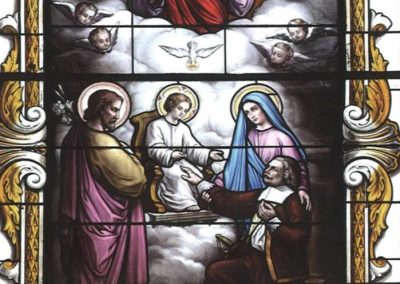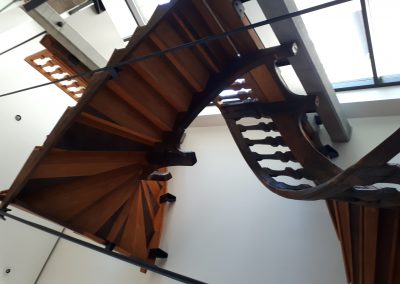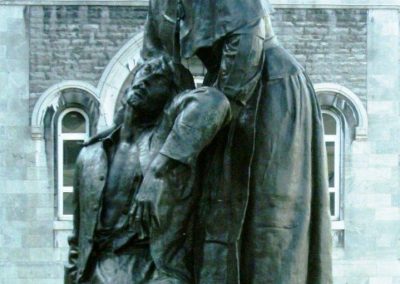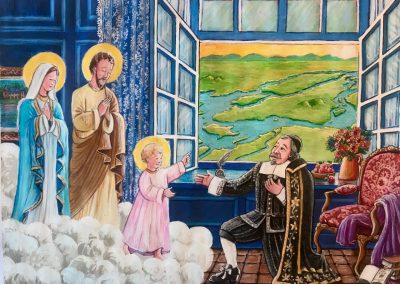The mystical origin of Montreal
Venerable Jérôme Le Royer and the Foundation of the Hospitalières
The Jesuits in New France published an annual journal called The Jesuit Relations. These writings, which arrived in Paris, were eagerly awaited by the public and read avidly by all classes of society. They were almost like adventure novels, sparking the imagination and enthusiasm of many readers. It can be said that these journals alone inspired many individuals—gentlemen, bourgeois, artisans, and farmers—to embark for Canada, not to mention those who were moved to religious vocations.
One such man was Jérôme Le Royer de La Dauversière, a gentleman from La Flèche in Anjou, who had a deep desire to contribute to the evangelization of Canada. As he approached his 33rd birthday, he went to the chapel of Notre-Dame du Chef du Pont in La Flèche for the Feast of the Purification. It was February 2, 1630, and in the chapel, each member of the congregation, holding a candle, listened in silence to the profound words of the liturgical text: “And your praise extends to the ends of the earth.”
At the moment of communion, Monsieur de La Dauversière heard an inner voice urging him: “My son, consecrate yourself, with your wife and children, to the Holy Family. You will found an order of nuns and consecrate them to my foster father, Joseph. These nuns will go to Montreal, Canada, and establish the Hôtel-Dieu there.”
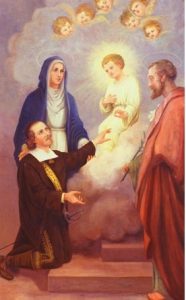 In 1633, when Jérôme Le Royer was gravely ill and received the sacrament of the dying, he used this time to develop his foundation project. During his illness, he experienced mystical conversations with Christ and recorded several notebooks of these dialogues. Thanks be to God, he recovered from his illness.
In 1633, when Jérôme Le Royer was gravely ill and received the sacrament of the dying, he used this time to develop his foundation project. During his illness, he experienced mystical conversations with Christ and recorded several notebooks of these dialogues. Thanks be to God, he recovered from his illness.
In January 1635, Jérôme traveled to Notre-Dame Cathedral in Paris to pray to the Virgin Mary. After receiving communion, during his fervent prayers, he found himself in the presence of the Holy Family. Mary took him by the hand and presented him to Jesus, saying: “Here is your faithful servant.” The Lord received him kindly and said, “From now on, you will be my faithful servant. I will clothe you with strength and wisdom. You will have your guardian angel as your guide. Work hard at my work. My grace is sufficient for you and will not fail you.”
In 1636, he laid the foundations of the Confraternity of St. Joseph, which would later become the Institute of the Religious Hospitallers of St. Joseph. Jérôme Le Royer renovated the chaplaincy of Sainte-Marguerite in La Flèche, transforming it into a hospital and naming it the “Hôtel-Dieu.” These dilapidated buildings, once used as shelters for the poor, were referred to as “Maison-Dieu.”
Eventually, the first candidate for the future community, Marie de la Ferre, was revealed to him, and the first chapter of the constitutions was dictated to him. Understanding both the demands of this calling and his own limitations, Jérôme cried out in anguish: “Alas! Lord, who am I to undertake such a great enterprise?” He received this word from God: “Obey, obey, my grace is sufficient for you.” Jérôme then wrote down the divine instructions and the first chapter of the constitutions for the future congregation, now known as the “Religious Hospitallers of St. Joseph.”
Vision of the Island of Montreal
Revelations soon confirmed the providential nature of his calling. One morning in 1640, as he was reading one of these Relations, which spoke highly of the island of Montreal as an ideal location to establish a mission and receive the indigenous people, he had a mysterious vision. This vision clearly and truthfully showed him the very site of Montreal. Monsieur de La Dauversière was convinced that this vision was a divine invitation. He spoke to his confessor, the Reverend Father Chaveau, rector of the Collège de la Flèche, who affirmed his feelings. Jérôme soon shared his mystical enthusiasm with Baron de Fancamp, a wealthy gentleman who had recently joined him, seeking spiritual guidance to better serve Our Lord.

The Providential Meeting with Father Jean-Jacques Olier
In 1640, Jérôme Le Royer went to Paris accompanied by Pierre Chevrier and Baron de Fancamp to present his mission project to Father Charles Lalement, procurator of the Jesuit missions in Canada. Father Lalement had been the first superior of the Jesuits in Quebec City (1625–1629) and was procurator in Paris for the New France mission (1638–1650). Jérôme later met Pierre Séguir, chancellor of France, at Château Meudon, where he encountered Abbé Jean-Jacques Olier, the founder of the Seminary of Saint-Sulpice. Olier had also received divine revelations regarding Montreal. Like Monsieur de La Dauversière, he had experienced a vision of the island’s geographical location and its providential future. Both men shared the same desire to evangelize by establishing a mission in New France. Olier would later refer to Montreal as a place of wonderful importance, where the first chapel would be dedicated to the Holy Virgin, and a Christian city would rise under the name of Ville-Marie.
Father Jean-Jacques Olier
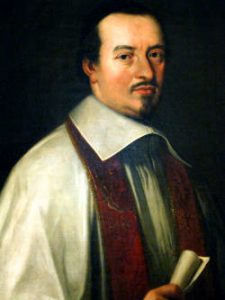
Father Jean-Jacques Olier
Together, Le Royer and Father Olier founded a missionary society called Notre-Dame de Montréal. In 1640, the society acquired the island of Montreal. The contract of transfer was signed in Vienna on August 7, 1640, and the acquisition was completed on December 7.
The Society of Montreal was effectively formed, with key figures like Olier, La Dauversière, and Fancamp leading the effort. The site, which had been given to Jean de Lauson, Intendant of the Dauphiné, was secured, and a leader was sought to lead the planned expedition and establish the new settlement. Jesuit Father Charles Lalement recommended Paul de Chomedey, sieur de Maisonneuve, a man with the necessary qualities for the task.
Departure for New France
Paul de Chomedey, sieur de Maisonneuve, was the right man for the mission: mystical yet practical, idealistic yet sensible, brave yet wise, pious yet charitable—one could describe him as a lay monk. In July 1641, he departed La Rochelle with two ships. Along with about thirty colonists (others had left simultaneously from Dieppe), he took Jeanne Mance, a woman from Langres in Champagne, who was equally moved by the call to Canada.
In the Atlantic, the two ships were separated by a storm. The ship carrying Mademoiselle Mance arrived in Quebec City on August 8, while the ship with Maisonneuve reached port on August 20. Upon his arrival, Maisonneuve found ten future settlers from Dieppe already at work building a store on the waterfront, on land donated by Mr. de Montmagny for the Montreal Company.
The Mount Royal Cross
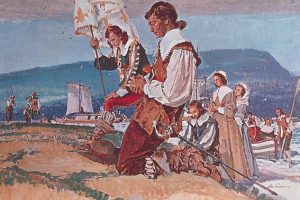 On May 17, 1642, Maisonneuve, Jeanne Mance, and a group of about 40 men and women landed on the island of Montreal and founded Ville-Marie.
On May 17, 1642, Maisonneuve, Jeanne Mance, and a group of about 40 men and women landed on the island of Montreal and founded Ville-Marie.
In December 1642, the St. Lawrence River suddenly overflowed, threatening to flood the fort of Ville-Marie. Monsieur de Maisonneuve promised that if God preserved the settlement from flooding, he would carry a cross to the top of Mount Royal and plant it there. On the night of December 25, the waters rose in large waves, filling the fort’s ditches and threatening to destroy everything. But the waters stopped at the threshold of the gate and then receded.
On January 6, 1643, the Feast of the Epiphany, everything was ready. The cross was solemnly blessed, and a procession began. Monsieur de Maisonneuve carried the heavy cross on his shoulders alone for a league. Once the cross was in place, Father Duperron celebrated mass, and several people, including Madame de La Peltrie, took communion. The cross, containing precious relics, became a site of pious pilgrimage.
Sources:
Les Français au Canada (du Golfe Saint-Laurent aux Montagnes-Rocheuses), by Cerbelaud Salagnac, Éditions France-Empire, 68, rue Jean-Jacques Rousseau – Paris (1er), 1963.
http://www.cursillos.ca/action/modeles/101m-jerome-le-royer.htm

